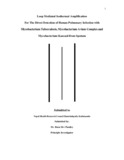Please use this identifier to cite or link to this item:
https://hdl.handle.net/20.500.14356/615Full metadata record
| DC Field | Value | Language |
|---|---|---|
| dc.contributor.author | Nepal Health Research Council (NHRC), Ramshah Path, Kathmandu, Nepal | |
| dc.date.accessioned | 2012-12-26T23:29:34Z | |
| dc.date.accessioned | 2022-11-08T10:17:07Z | - |
| dc.date.available | 2012-12-26T23:29:34Z | |
| dc.date.available | 2022-11-08T10:17:07Z | - |
| dc.date.issued | 2009 | |
| dc.identifier.uri | http://103.69.126.140:8080/handle/20.500.14356/615 | - |
| dc.description.abstract | Introduction: Rapid species identification and proper use of drug sare key requirements for the effective treatment and case management of tuberculosis. The development and evaluation of new diagnostic technique, which can diagnose causative agent in simple and rapid way, is the necessity of this century. Loop-Mediated Isothermal Amplification (LAMP) provides new possibilities of above requirements for direct detection of M. tuberculosis, M. avium complex and M. kansasiiin sputum samples. Objectives: To diagnose Mycobacaterium Tuberculosis early and accurately and to identify the prevalence of atypical mycobactera in Nepal. The study further intended to initiate LAMP as a diagnostic tools in hospital laboratories of Nepal. Materials and Methods:This study was carried out 130 sputum samples from suspected pulmonary tuberculosis patients were included in this study. All these samples were processed for flurochrome staining and were subjected to culture and LAMP. Thus sputum specimens were included in this study to compare them with microscopy, culture and LAMP. Results: Among them 50(38.46%) were found to bepositive by flurochrome staining, culture and LAMP. Similarly 48(36.92%) samples were negative by all diagnostic methods. 1(0.77%) microscopy and culture positive sample was negative by LAMP. Similarly 3(2.31%) microscopy and LAMP positive cases were negative by culture. 3(2.31%) culture positive cases were negative by both microscopy and LAMP. Eight (6.16%) culture negative cases were positive by LAMP where as 17(13.07%) microscopy negative samples were positive by culture and LAMP. Out of 78(100%) total LAMP positive cases, 76(97.44%) were positive for M. tuberculosis and remaining 2 (2.56%) were positive for M. intracellular. While comparing LAMP results with gold standard culture, the sensitivity, specificity, predictive value of positive test, predictive value of negative test, percentage of false negative and percentage of false positive of LAMP were found to be 94.36%, 81.36%, 85.90%, 92.31%, 5.63% and 18.64% respectively. Similarly, LAMP had sensitivity 98.14% and specificity 67.11% while compare with microscopy. Discussion and Conclusion: LAMP is highly sensitive and specific molecular technique, which can be used effectively for the diagnosis of clinically, microscopically, and culturally confusing cases thus facilitating the effective treatment and case management of tuberculosis and other atypical mycobacterial infection. Due to its easy operation and rapid amplification efficiency, it can be used in well-equipped laboratories for clinical use if sample preparation, nucleic acid extraction and cross-contamination controls are addressed. | en_US |
| dc.language.iso | en_US | en_US |
| dc.publisher | Nepal Health Research Council | en_US |
| dc.subject | M. tuberculosis | en_US |
| dc.subject | M avium complex | en_US |
| dc.subject | M. kansasii | en_US |
| dc.subject | LAMP | en_US |
| dc.title | Loop Mediated Isothermal Amplification For The Direct Detection of Human Pulmonary Infection with Mycobacterium Tuberculosis, Mycobacterium Avium Complex and Mycobacterium Kansasii from Sputum | en_US |
| dc.type | Technical Report | en_US |
| Appears in Collections: | NHRC Research Report | |
Items in DSpace are protected by copyright, with all rights reserved, unless otherwise indicated.

